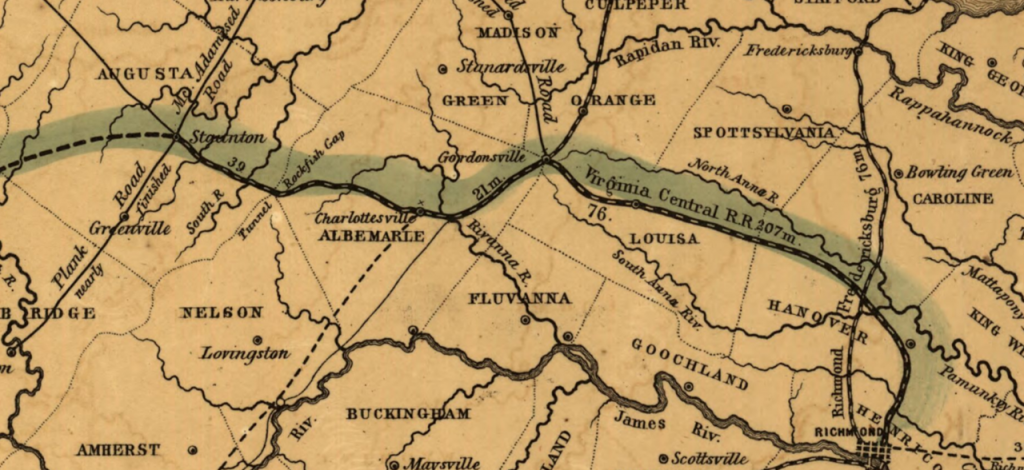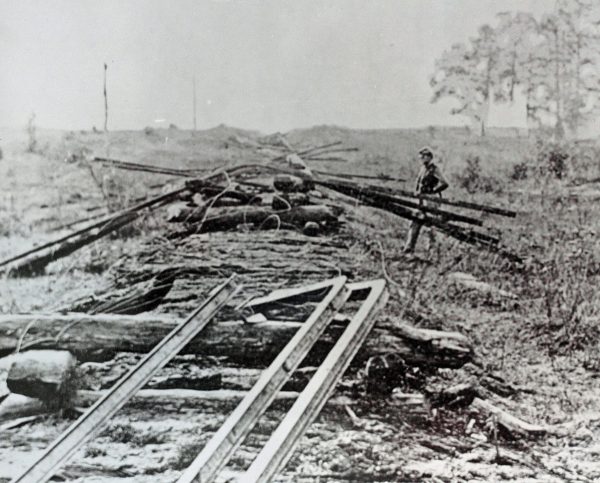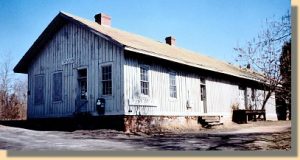Railroads – The Virginia Central Railroad: A Target For Union Raids
 The Virginia Central Railroad was chartered as the Louisa Railroad in 1836 by the Virginia Board of Public Works. The name was changed to the Virginia Central Railroad in 1850. It ran from westward from Richmond and ended in Gordonsville, where it met the Orange & Alexandria Railroad. No Confederate railroad was targeted more, and damaged by repeated Union cavalry raids more than the Virginia Central.
The Virginia Central Railroad was chartered as the Louisa Railroad in 1836 by the Virginia Board of Public Works. The name was changed to the Virginia Central Railroad in 1850. It ran from westward from Richmond and ended in Gordonsville, where it met the Orange & Alexandria Railroad. No Confederate railroad was targeted more, and damaged by repeated Union cavalry raids more than the Virginia Central.
From Gordonsville, the Virginia Central was originally intended to connect eastern Virginia with Harrisonburg in the Shenandoah Valley, crossing the Blue Ridge Mountains at Swift Run Gap, but construction costs were prohibitive. The Commonwealth of Virginia, always keen to help with “internal improvements”, not only owned a small percentage of Virginia Central stock, but incorporated and financed the Blue Ridge Railroad to accomplish the hard and expensive task of crossing the first mountain barrier to the west. Under the leadership of the great early civil engineer Claudius Crozet, the Blue Ridge Railroad crossed the mountain using four tunnels, including the 4,263 foot Blue Ridge Tunnel at the top of the mountain, then one of the longest tunnels in the world.
While the Blue Ridge Railroad tackled the crossing of the mountain, the Virginia Central extended westward from the base of the mountains. It crossed the Shenandoah Valley and the westward barrier of the valley, Great North Mountain, reaching a point known as Jackson’s River Station, at the foot of Alleghany Mountain in 1856, at the site of the modern town of Clifton Forge, Virginia. The completed Virginia Central Railroad covered 200 miles, and was intended to serve as a link to the Richmond, Fredericksburg & Potomac Railroad (“RF&P”), which was the main north/south line from Washington, D.C.

During the Civil War, the Virginia Central became one of the Confederacy’s most important lines, carrying food from the Shenandoah Valley to Richmond, and ferrying troops back and forth as the campaigns frequently surrounded its tracks. The railroad carried more than 100,000 passengers between 1861 and 1864, which demonstrates how heavily used it was, even as war raged all around it. On more than one occasion, it was used in actual tactical operations, transporting troops directly to the battlefield. That made it a prime target for Union armies, and by the end of the war had only five miles of track still in operation and $40 in gold in its treasury.
Due to manpower shortages in 1863 resulting from conscription of all available white men into the Confederate armies, the management of the Virginia Central purchased 35 slaves for nearly $84,000 in order to ensure that there was sufficient manpower available to do the work needed to keep the trains running. Despite this expenditure, Union targeting of the railroad kept parts of it inoperative for extended periods of time.
Even a partial list of the damage demonstrates the difficulty that the Virginia Central experienced in maintaining operations:
- The first major damage to the railroad occurred on May 17, 1861, when a Union detachment took possession of the Jackson’s River Depot and burned the bridge of the Cowpasture River, and other trestles near Atlee’s Station were burned.
- In 1862, Maj. Gen. George B. McClellan destroyed the Virginia Central’s bridge over the South Anna River. Maj. Gen. George Stoneman’s men ripped tracks between Hanover and Atlee’s Station.
- In July of that year, Union raiders destroyed Beaver Dam Station and a great deal of other equipment, and then continued west along the railroad to Frederick’s Hall Station.

- During Maj. Gen. John Pope’s Virginia campaign of August 1862, two different Union cavalry raids led by Brig. Gen. John Hatch targeted the junction of the Virginia Central and the Orange & Alexandria at Gordonsville, but Hatch’s timidity combined with resistance from Confederate cavalry turned those raids back before they could reach their objective.
- In May 1863, during the Stoneman Raid that occurred during the Chancellorsville Campaign, Union cavalry raided the town of Louisa Court House and burned the Hanover depot.
- The year of 1864 saw countless raids on the Virginia Central by Union forces. Beaver Dam Station was burned again, and the bridge over the Chickahominy River near Richmond was destroyed. Lt. Gen. Ulysses S. Grant’s advancing armies tore up the tracks between Anderson and Hewlett. Raids by Union cavalry under Brig. Gen. William W. Averell and Brig. Gen. George Crook attacked the western portions of the railroad in the spring of 1864.
- In addition to the raids listed above, two major engagements occurred along the Virginia Central’s tracks: The North Anna Campaign of May 1864, where Union troops intended to destroy the junction of the Virginia Central and the RF&P at Doswell ended in a stalemate, and the brutal two day slugging match between Union and Confederate cavalry at Trevilian Station in Louisa County on June 11-12, 1864.
- Gen. Jubal A. Early’s troops used the Virginia Central to carry them to Charlottesville, which allowed them to reach Lynchburg, Virginia in time to defeat the army of Maj. Gen. David Hunter on June 17, 1864.
- Union cavalry again targeted the critical railroad junction at Gordonsville during the late fall of 1864.
The 1864 annual report to the shareholders of the Virginia Central stated:
In several raids, the enemy has burned seven water stations, four passenger houses, one engine house, eighteen bridges of over thirty feet span, and many smaller ones, tore up and burned over eighteen miles of track, three turntables, thirty-six cars, 20,000 cross ties, and a large amount of wood, besides other damages which will not be particularized. The enemy has been at every station between Gordonsville and Richmond, except Hanover Junction and every station west of the Blue Ridge. The loss of revenue to the company was large, but I believe the army suffered little or no inconvenience, and as this was the great object of the enemy, his operation may be considered a failure.

However, the continuous Union raids on the Virginia Central made it very difficult for the company to maintain sufficient rolling stock to fulfill the railroad’s needs. By 1865, cars were being destroyed faster than they could be made. A few months after the end of the Civil War, the railroad’s entire rolling stock consisted of 29 engines, 12 first class passenger cars, 3 second class passenger cars, 42 express cars, and 159 freight cars. That’s it. Destruction of the tracks, bridges, etc., and of its rolling stock meant that the Virginia Central had major financial problems for the entire war.
By the spring of 1865, in order to keep the eastern portion of the line operational, rails from the western end were torn up and used to replace those damaged in Federal raids. By the surrender at Appomattox on April 9, only five miles of track remained operational out of 200.
In spite of the damage that it suffered at the hands of the Union armies, the Virginia Central remained a critical logistical link for the Confederacy until the bitter end. And despite the damage recounted herein, trains ran over the entire route of the Virginia Central, all the way from Richmond to Clifton Forge, by July 1865, just three months after the Confederate surrender at Appomattox. To this day, the route of the Virginia Central remains a busy and active line, carrying freight trains operated by CSX.
As always Eric J Wittenberg very educational and very entertaining article I don’t know how you do it but keep cranking them out brother. I can’t wait for your Chickamauga well booked in December I already got it pre-order I was told that we can’t get them signed even if we order them from your publisher mr. Theodore, if that has changed and we can get them signed let me know cuz I always want your book signed as you know, great job sir without question you put out the most quantity while maintaining high-quality books and you have for some time. Now as a side note Timothy B Smith is going down your path but you been doing it for years so he’s got a ways to go to catch up but he’s definitely on the right track you guys are great
Excellent article! My current book read just finished discussing George Crook’s destruction around the Jackson River Depot. May 1862.